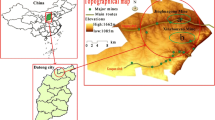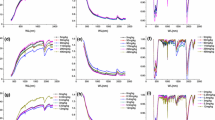Abstract
In order to obtain Pb content in soil quickly and efficiently, a multivariate linear regression (MLR) and a principal component regression (PCR) Pb content estimation model were established on the basis of hyperspectral techniques, and their applicability in different soil types was evaluated. Results indicated that Pb exhibited strong spatial heterogeneity in the study area, and more than 82% of the samples exceeded the background value. In addition, the pollution range was large. Pb was sensitive in the near-infrared band, and the correlation of absorbance (AB) was most significant of all the transformed forms. Both models achieved optimal stability and reliability when AB was used as an independent variable. Compared with the PCR model, the stability, fitting accuracy, and predictive power of the MLR model were superior with a coefficient of determination, root mean square error, and mean relative error of 0.724%, 24.92%, and 28.22%, respectively. Both models could be applied to different soil types; however, MLR had better applicability compared with PCR. The PCR model that distinguished different soil types had better reliability than one that did not. Thus, the model established via hyperspectral techniques can achieve large-area, rapid, and efficient soil Pb content monitoring, which can provide technical support for the treatment of heavy metal pollution in soil.






Similar content being viewed by others
References
Cheng XF, Song TT, Chen Y et al (2017) Retrieval and analysis of heavy metal content in soil based on measured spectra in the Lanping Zn–Pb mining area, western Yunnan Province. Acta Petrol Mineral 36(1):60–69
China National Environmental Monitoring Center (1990) Chinese soil element background value. China Environmental Science Press, Beijing
Gholizadeh A, Borůvka L, Saberioon MM et al (2015) Comparing different data preprocessing methods for monitoring soil heavy metals based on soil spectral features. Soil Water Res 10(4):218–227
Guo YK, Cao XY, Xie Q et al (2015) Primary research on the inversion model of soil heavy metal based on simulation multi-spectral data. Eng Surv Mapp 24(12):7–16
Jiang ZL, Yang YS, Sha JM (2017) Application of GWR model in Vis–NIR spectroscopy prediction of soil heavy metals. Acta Geogr Sin 72(3):533–543
Li X, Liu L, Wang Y et al (2013a) Heavy metal contamination of urban soil in an old industrial city (Shenyang) in Northeast China. Geoderma 192:50–58
Li YB, Luo GJ, Chen AY et al (2013b) A typical case study on evolution of karst rocky desertification in Houzhaihe, Puding County, central Guizhou Province, China. Geogr Res 32(5):828–838
Li GW, Gao XH, Yang LY et al (2017) Estimating soil organic matter contents from different soil particle size using visible and near-infrared reflectance spectrum: a case study of the Huangshui watershed. Chin J Soil Sci 6:1360–1370
Lu Q, Wang SJ, Bai XY et al (2019) Rapid inversion of heavy metal concentration in karst grain producing areas based on hyperspectral bands associated with soil components. Microchem J 148:404–411
Ma WB, Tan K, Li HD et al (2016) Hyperspectral inversion of heavy metals in soil of a mining area using extreme learning machine. J Ecol Rural Environ 32(2):213–218
Maliki AA, Bruce D, Owens G (2014) Prediction of lead concentration in soil using reflectance spectroscopy. Environ Technol Innov s1-2(1):8–15
Peng J, Chi CM, Xiang HY et al (2014) Inversion of soil salt of content based on continuum-removal method. Acta Pedol Sin 3:459–469
Ren HY, Zhuang DF, Singh AN et al (2009) Estimation of As and Cu contamination in agricultural soils around a mining area by reflectance spectroscopy: a case study. Pedosphere 19(6):719–726
Shi Z (2014) Principle and method of soil surface Vis–NIR spectroscopy remote sensing. Science Press, Beijing, p 31
Song L, Jian J, Tan DJ et al (2015) Estimate of heavy metals in soil and streams using combined geochemistry and field spectroscopy in Wan-sheng mining area, Chongqing, China. Int J Appl Earth Obs Geoinf 34(1):1–9
Song B, Tian ML, Chen TB et al (2017) Characterization of Pb contents in typical soils of Guangxi and risk assessment based on literature date. Acta Pedol Sin 54(1):92–107
Sun W, Zhang X, Sun X et al (2018) Predicting nickel concentration in soil using reflectance spectroscopy associated with organic matter and clay minerals. Geoderma 327:25–35
Tan K, Ye YY, Du PJ et al (2014) Estimation of heavy metal concentrations in reclaimed mining soils using reflectance spectroscopy. Spectrosc Spectr Anal 34(12):3317
Tan K, Wang HM, Chen LH et al (2020) Estimation of the spatial distribution of heavy metal in agricultural soils using airborne hyperspectral imaging and random forest. J Hazard Mater 382:120987
Tao C, Chang Q, Jing L et al (2016) Identification of soil heavy metal sources and improvement in spatial mapping based on soil spectral information: a case study in northwest China. Sci Total Environ 565:155–164
Tao C, Wang YJ, Zhou B et al (2018) Assessment and analysis of migrations of heavy metal lead and zincin soil with hyperspectral inversion model. Spectrosc Spectr Anal 38(6):1850–1855
Teng J, He ZW, Ni ZY et al (2016) Spectral response and inversion models for prediction of total copper content in soil of Xifanping mining area. Spectrosc Spectr Anal 36(11):3637–3642
Tian SQ, Wang SJ, Bai XY et al (2019) Hyperspectral prediction model of metal content in soil based on the genetic ant colony algorithm. Sustainability 11(3197):1–21
Tu YL, Zou B, Jiang XL et al (2018) Vis–NIR spectroscopy remote sensing based modeling of Cu content in mining soil. Spectrosc Spectr Anal 38(2):575–581
Wang L, Lin QZ, Jia D et al (2007) Study on the prediction of soil heavy metal elements content based on reflectance spectra. J Remote Sens 11(6):906–913
Wang J, Cui L, Gao W et al (2014) Prediction of low heavy metal concentrations in agricultural soils using visible and near-infrared reflectance spectroscopy. Geoderma 216(4):1–9
Wang HB, Zhao ZQ, Yi L et al (2017) Leaf area index estimation of spring maize with canopy Vis–NIR spectroscopy data based on linear regression algorithm. Spectrosc Spectr Anal 37(5):1489–1496
Wang F, Gao J, Zha Y (2018) Vis–NIR spectroscopy sensing of heavy metals in soil and vegetation: feasibility and challenges. ISPRS J Photogramm Remote Sens 136:73–84
Wu MZ, Li XM, Sha JM (2014) Spectral inversion models for prediction of total chromium content in subtropical soil. Spectrosc Spectr Anal 34(6):1660–1666
Xu MX, Wu SH, Zhou SL et al (2011) Vis–NIR spectroscopy reflectance models for retrieving heavy metal content: application in the archaeological soil. J Infrared Millim Waves 30(2):109–114
Xu D, Sun L, Luo JS (2013) Wavelet denoising of Vis–NIR spectroscopy remote sensing imagery based on multiple linear regression. Remote Sens Inf 28(6):78–86
Yao P, Zhang D, Zhang SR et al (2014) Modeling to predict lead and nickel contents in soil of the mid-and lower reaches of shiting river using RS and GIS. J Agro-Environ Sci 33(1):95–102
Ye Q, Jiang X, Li X et al (2017) Comparison on inversion model of soil organic matter content based on Vis–NIR spectroscopy data. Trans Chin Soc Agric Mach 48(3):164–172
Zhang XB, Wang SJ, Cao JH et al (2010) Features of water loss and soil erosion and some scientific problems on karst rocky desertification in Southwest China karst area. Carsologica Sin 29(3):274–279
Zhang W, Gao XH, Yang Y et al (2014) Estimating heavy metal contents for topsoil based on spectral analysis: a case study of Yushu and Maduo counties in the three-river source region. Soils 6:1052–1060
Zhang L, Wu Q, Liu S et al (2015) Research on monitoring of Pb content in the sewage irrigation area of Longkou city using Vis–NIR spectroscopy data. Environ Eng 33:114–122
Zhang Q, Zhang H, Liu W et al (2017) Inversion of heavy metals content with Vis–NIR spectroscopy reflectance in soil of well-facilitied capital farmland construction area. Trans Chin Soc Agric Eng 33(12):230–239
Zhang ZM, Zhou YC, Wang SJ et al (2018) Spatial distribution of stony desertification and key influencing factors on different sampling scales in small karst watersheds. Int J Environ Res Public Health 15(4):743
Acknowledgements
This research work was supported jointly by National Key Research Program of China (Nos. 2016YFC0502300 and 2016YFC0502102), Chinese Academy of Science, and Technology Services Network Program (No. KFJ-STS-ZDTP-036), International Cooperation Agency International Partnership Program (Nos. 132852KYSB20170029, 2014-3), Guizhou High-level Innovative Talent Training Program “Ten” Level Talents Program (No. 2016-5648), United Fund of Karst Science Research Center (No. U1612441), International Cooperation Research Projects of the National Natural Science Fund Committee (Nos. 41571130074 and 41571130042), Science and Technology Plan of Guizhou Province of China (No. 2017–2966).
Author information
Authors and Affiliations
Corresponding author
Ethics declarations
Conflict of interest
On behalf of all authors, the corresponding author states that there is no conflict of interest.
Rights and permissions
About this article
Cite this article
Tian, S., Wang, S., Bai, X. et al. Hyperspectral estimation model of soil Pb content and its applicability in different soil types. Acta Geochim 39, 423–433 (2020). https://doi.org/10.1007/s11631-019-00388-0
Received:
Revised:
Accepted:
Published:
Issue Date:
DOI: https://doi.org/10.1007/s11631-019-00388-0




